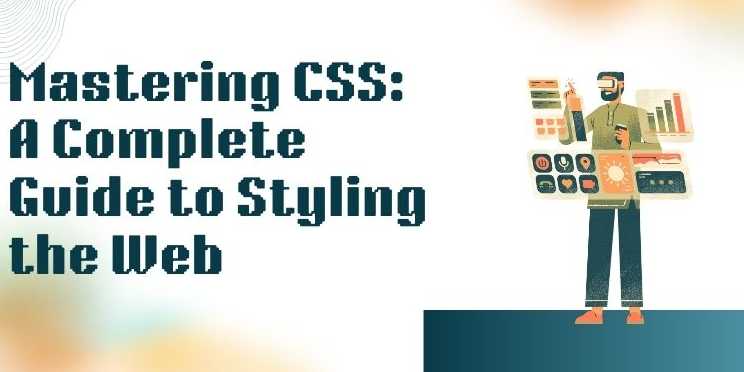Mastering CSS: A Complete Guide to Styling the Web

Chapter 4: Typography and Visual Styling
This chapter focuses on the art of visual presentation
through text styling, fonts, colors, and backgrounds. Typography is key
to both readability and brand identity, while proper styling adds polish and
professionalism to your web interfaces.
🧠 Why This Chapter
Matters
CSS gives you powerful tools to:
- Define
clean, accessible typography
- Apply
color schemes and branding
- Enhance
visual hierarchy
- Set
dynamic and engaging backgrounds
In this chapter, we’ll cover everything you need to design
visually stunning UI components.
✅ 1. CSS Text Styling
Control the appearance of text using a variety of
text-related properties.
Common Properties:
p
{
color: #333;
text-align: justify;
text-decoration: underline;
letter-spacing: 1px;
text-shadow: 1px 1px 2px gray;
}
|
Property |
Description |
|
color |
Sets the text color |
|
text-align |
Aligns text (left, right, center, justify) |
|
text-decoration |
Adds underline, overline, etc. |
|
letter-spacing |
Adjusts space between characters |
|
text-shadow |
Adds shadow to text |
✅ 2. CSS Fonts
Fonts define your site’s voice and personality. Use web-safe
fonts or import custom fonts.
Font Properties:
h1
{
font-family: 'Arial', sans-serif;
font-size: 2rem;
font-weight: bold;
font-style: italic;
}
|
Property |
Description |
|
font-family |
Font stack |
|
font-size |
Size of the text (px, rem) |
|
font-weight |
Thickness (normal, bold, 100–900) |
|
font-style |
normal, italic, oblique |
Importing Custom Fonts (Google Fonts)
<link
href="https://fonts.googleapis.com/css2?family=Roboto&display=swap"
rel="stylesheet">
body
{
font-family: 'Roboto', sans-serif;
}
✅ Always include fallback fonts
for performance and accessibility.
✅ 3. CSS Colors
Colors are defined using:
- Named
colors: red, green, blue
- HEX:
#ff0000
- RGB:
rgb(255, 0, 0)
- RGBA:
rgba(255, 0, 0, 0.5) (adds transparency)
- HSL:
hsl(0, 100%, 50%)
Example:
.primary
{
color: hsl(220, 80%, 60%);
background-color: rgba(0, 0, 0, 0.1);
}
✅ Use color tools like Coolors or Adobe Color to create
palettes.
✅ 4. CSS Backgrounds
Use background properties to add color, images, or gradients
to elements.
🔹 Basic Background
.hero
{
background-color: #f4f4f4;
}
🔹 Background Image
.banner
{
background-image: url('image.jpg');
background-size: cover;
background-position: center;
}
🔹 CSS Gradients
.gradient-box
{
background: linear-gradient(to right,
#4facfe, #00f2fe);
}
|
Property |
Description |
|
background-color |
Solid color |
|
background-image |
File or gradient |
|
background-repeat |
no-repeat, repeat-x, etc. |
|
background-size |
cover, contain, custom sizes |
|
background-position |
Aligns the image (center, top) |
✅ 5. CSS Icons
Use icons to enhance UI without heavy image files.
🔹 Font Awesome (Most
Popular)
<link
rel="stylesheet"
href="https://cdnjs.cloudflare.com/ajax/libs/font-awesome/6.0.0/css/all.min.css">
<i
class="fas fa-user"></i>
🔹 Using SVG Icons
<svg
width="24" height="24" fill="currentColor">
<use
xlink:href="#icon-arrow-right"></use>
</svg>
✅ SVGs are scalable, lightweight,
and styleable with CSS.
✅ Recap Table: Typography and
Visual Styling
|
Feature |
Common Properties |
|
Text Styling |
text-align, text-shadow, letter-spacing |
|
Fonts |
font-family, font-size, font-weight, italic |
|
Color Formats |
hex, rgb, rgba, hsl, named colors |
|
Backgrounds |
background-color, background-image, gradient |
|
Icons |
Font Awesome, SVGs |
FAQs
1. What is the difference between inline, internal, and external CSS?
Inline CSS is written inside HTML tags, internal CSS is placed within a <style> tag in the head, and external CSS is stored in a separate file and linked to the HTML. External CSS is preferred for maintainability.
2. What is the cascading order in CSS?
CSS applies rules in a cascading manner: browser default → external → internal → inline. Specificity, importance (!important), and source order also affect which styles are applied.
3. What is the box model in CSS?
The box model describes how elements are structured with content, padding, border, and margin. Understanding it is essential for layout and spacing.
4. What is specificity in CSS?
Specificity determines which rule takes precedence when multiple rules target the same element. Inline styles > ID selectors > Class selectors > Element selectors.
5. What is the difference between Flexbox and Grid?
Flexbox is best for one-dimensional layouts (row or column), while Grid is suitable for two-dimensional layouts (rows and columns together).
6. How do media queries work in CSS?
Media queries apply styles based on device conditions like screen width. They are essential for creating responsive websites.
7. What are pseudo-classes and pseudo-elements?
Pseudo-classes like :hover and :focus apply styles based on user interaction. Pseudo-elements like ::before and ::after style specific parts of an element.
8. Why should you avoid using !important frequently?
Using !important overrides all other rules, which can make debugging harder and affect maintainability. Use it only when absolutely necessary.
9. What tools can enhance writing CSS?
Tools like SASS, LESS, Tailwind CSS, and PostCSS help in writing cleaner, more scalable CSS with features like nesting, variables, and mixins.
10. How can CSS impact website performance?
Efficient CSS can improve load time and user experience. Avoid unnecessary styles, minimize CSS files, and use compression tools like cssnano.


Comments(0)